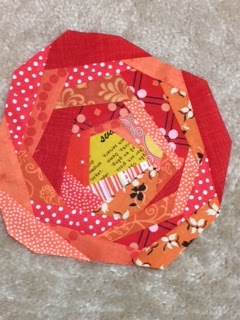Hi! This is Wendi, and I am the project manager for our Q2 community outreach quilt.
Once again we've agreed to make a quilt for Fisher House of the Emerald Coast supporting their silent auction and gala, a major fundraising event which benefits military and military families during times of medical need.
The vision for 2017's quilt is a bed of roses - literally! The blocks are improvisationally pieced roses inspired by Corey Yoder's Newtown Auction Pillow. Corey used a Quilt As You Go (QAYG) method, but our roses are going to remain unquilted until the top is put together.
Using the method below, you may create roses any size between 6" and 18". As you can see, these blocks are not square, so you will have estimate their size. They can be any color that you might see actual roses growing in a garden, although you might wish to stay away from white, since our background is going to be low volume on white. The blocks are super scrappy, but try to stay within one general color family - reds, oranges, pinks, yellows, etc. It's ok if your fabrics have other colors in them, but the fabrics should "read" your primary color.
So get out your scrap bag and let's get started.
Choose a small scrap of yellow or orange for your center. Since my block is going to be orange, I chose yellow. If your block is square, cut some of the corners off so that it is NOT square. I like to start out with 5 sides.
Choose the fabric for your first strip. It should be between 1" and 2-1/2" wide and slightly longer than the side of the center you intend to attach it to. You may use solids mixed in with your prints, but please do not use all solids. I generally start with narrower pieces and gradually add wider strips. Remember that you will be trimming the width frequently, so try not to begin with extremely narrow pieces.
Tip 1: Since the pieces in my scrap box tend to be very wrinkled, I find it helpful to press each piece before I sew them together. You may use starch, but I find that a light sprinkling of water or steam works well.
Tip 2: Since some of your edges will be on the bias, be careful not to stretch too much when you stitch and press.
Tip 3: Be sure to use a 1/4" seam. Seams that are too narrow tend to fray and pull apart, and we want our quilts to have quality construction.
Sew the two fabrics together.
Press the seam away from the center.
Trim off the excess.
Trim the other side. Try to avoid 90-degree angles.
Repeat the process on another center edge. Stitch.
Press.
Trim.
Trim the other side.
Repeat, building your rose "log-cabin style", adding a new strip to the next side in order, although it doesn't matter if you build to the left or to the right each time.
Stitch.
Press.
Trim. Here, I trimmed off the 2nd strip so that it was at an angle. Be sure to leave more than 1/4" all along your strip for your seam allowance.
Trim the other side and cut your strips at different angles each time to give interest to your "rose."
Repeat the entire process - Stitch. Press. Trim.... working your way around and around your "rose."
Trim off odd corners and try to avoid 90-degree angles and straight strips.
If you notice that you have a "corner" approaching 90-degrees, cut it off. As your "rose" grows, this will create a number of new "sides" to your flower.
Keep adding rows...
Pressing...
Trimming...
Avoiding straight strips and 90-degree corners...
And "grow" or "build" your flower...
Around and around until you are satisfied with its size...
Give it one last trim....
Until it makes you happy.
I try to balance the colors to avoid all the darker fabrics being on one side, but honestly, no matter how you put them together, these "roses" are pretty.
If you have any questions, give me a shout!







































